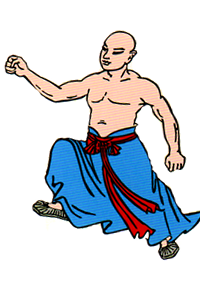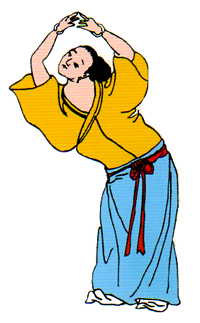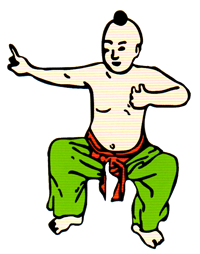The System of Health Qigong®
The Chinese Health Qigong Association introduced 4 sets of exercises in 2002 namely, Yi Jin Jing, Wu Qin Xi, Ba Duan Jin and Liu Zi Jue - Health Qigong®. These exercises were structured and choreographed drawing on all the benefits of hundreds of versions of the original exercises by some of China's finest Qigong masters, TCM professors and universities.
Great care has been taken during the process in order to make these exercises more accessible and suitable for people of all ages and all levels of physical fitness. These exercises were designed to offer excellent physical and mental health benefits and help combat conditions such as Arthritis, Osteoporosis, high blood Pressure, Heart Problems, Stress and depression etc.
Introduction to the original 4 sets
 Health Qigong Yi Jin Jing - Muscle and Tendon Strengthening exercise
Health Qigong Yi Jin Jing - Muscle and Tendon Strengthening exercise
The earliest description of Yi Jin Jing exercises can be found on a 2000-year-old brocade painting named 'Illustration of Qi Circulation' (Dao Yin), which was unearthed in the 1970s from an ancient tomb in Changsha, Hunan, China. From 526 AD on, monks of the Shaolin Monastery played an important role in the evolution of the Yi Jin Jing exercises. The earliest account of the modern 12-movement exercises is included in the Illustrations of Internal Exercise compiled by Pan Wei in 1858 in the Qing Dynasty.
As traditional Yi Jin Jing relies heavily on the traditional Chinese medicine theory of the Five Elements - metal, wood, water, fire, earth - different schools of the exercises have evolved, emphasizing this aspect in many works. The Health Qigong Yi Jin Ying absorbed the cream of the traditional 12-routine Yi Jin Ying exercises together with a modern scientific approach. The movements form continuous integrity, focusing on tendon stretching and bone flexing and combining softness with strength. An essential part of the routines is natural breathing and the integration of mind and body with a relaxed spirit to make the circulation of the vital energy (qi) as unimpeded as possible.
Yi Jin Jing movements require a full range of stretching, bending, flexing and twisting in multi-directional and wide-ranging motions of the bones and related joints. As the bones are flexed, the muscle groups, tendons, and ligaments are also stretched. This improves blood circulation, and nutrition supersession in the soft tissues of the motion-related areas, increases the flexibility and pliability of such soft tissues like muscles, tendons, and ligaments and enhances the mobility of the bones, joints, and muscles.
The exercises are centered on the twisting, flexing, and stretching of the spine, with the waist as the axis and are conducted at a slow and even pace. Such movements help to stimulate spinal and nerve cords to make them function more effectively, together with the exercise of limbs and internal organs. Strength, when required, is applied in a gradual manner and the muscles should be relaxed to combine strength with tenderness.
The Yi Jin Ying movements have been proven to be able to improve health, and fitness, prevent diseases, lengthen life, and improve intellect. Regular, correct practice has very impressive effects on the respiratory system, flexibility, balance, and muscular strength. It may also help to prevent and cure diseases of the joints, digestive, cardiovascular, and nervous system.
 Health Qigong Wu Qin Xi - Five Animals Frolics
Health Qigong Wu Qin Xi - Five Animals Frolics
The system of Five Animal Exercises was designed by Hua Tuo, a leading physician of the Eastern Han Dynasty (25-220 AD). Hua Tuo developed this system based on existing ancient Chinese traditional exercises following theories of the functions of the internal organs and meridians as well as the principles of the circulation of Qi and blood in the human body. His inspiration came from the careful observation and study of the characteristic behaviour of tigers, deer, bears, monkeys, and birds, concluding that wild creatures regularly performed certain exercises to build up their constitution and improve their life skills.
The Five Animal Exercises imitate the movements of five animals and combine physical with mental exercises. The physical movements are designed to show the courage and robustness of the tiger, the serenity, and poise of the deer, the steadiness and solidity of the bear, the nimbleness and dexterity of the monkey and the swiftness and grace of the bird. The physical movements are at all times integrated with the mental exercises which are supposed to imitate the spiritual activities and expressions of the animals.
The exercises have the aim of strengthening muscles and bones, promoting the circulation of Qi and blood, preventing and curing diseases, maintaining good health, and prolonging the life span. The external dynamic physical activities should be integrated with the static activities of the mind. Exercising limbs, waist, trunk, and spine can increase the movement range and physical efficiency.
Exercises of the fingers and toes are particularly emphasized for improving blood circulation to the extremities. Physical and psychological tests of people practicing Wu Qin Xi give high scores to their overall constitution, the functions of the various organs, mental attitude and power of perception, as well as physical fitness.
The movements are simple and easy to remember as well as very safe and can be exercised by people of different age groups and stages of practice.

Health Qigong Ba Duan Jin - Eight Treasures
The Eight-section Exercises date back to the Song Dynasty (960-1279) and its easy movements and impressive effects on health make it a gem in China's health and fitness culture. The purpose of the exercises is to increase internal energy circulation through spiritual cultivation and physical exercises so as to improve health and fitness.
Deep natural breathing is required during the practice of the routines, without any constraint. It has been proved that the practice of Ba Duan Jin improves the respiratory system, limb strength, and flexibility of the joints, fortifies the nerves as well as enhances the general balance.
It improves cardiovascular function and helps to cure such illnesses as coronary artery sclerosis and osteoporosis. It strengthens one's immune system to a degree, delays the aging process, and also improves one's mental health. 
Health Qigong Liu Zi Jue - Six healing Sounds
The Six Sounds is a traditional health and fitness practice focused on the breath-control. The exercises regulate and control the rise and fall of Qi (vital energy) inside the body and related inhalation and exhalation through six different mouth forms and pronunciations.
As these practices strengthen the liver, heart, spleen, lungs, kidneys, and triple heater, respectively, Liu Zi Jue helps to balance the energy and functions of the internal organs. The exercises feature slow, gentle, extended, and graceful movements and are suitable for people of all ages and conditions of health.
A significant finding of benefits includes;
- increase muscle strength and flexibility
- improve lower back pain
- encourage blood circulation
- helps to combat stress and depression
- Better functioning of internal organs, beneficial to people suffering from Diabetes, Heart Problems, Kidney problems, etc.
- Reduce high blood pressure
- Improvement of mental attitude and power of perception as well as overall physical fitness
- improvement in the flexibility of joints, thus beneficial to people with Arthritis.
- Reduce the loss of Calcium thus improve bone density, thus beneficial to people suffering from Osteoporosis
- The cardiovascular and respiratory functions are markedly improved
Additional Sets of Health Qigong Exercises
More sets of Health Qigong exercises have gone through a tough trial and assessment process and have become available since 2006. The British Health Qigong Association is one of the few professional organisations with the in-depth knowledge and expertise to teach these exercises in the UK, Europe, and further afield.
These additional sets of exercises include;
- Health Qigong 12 Duan Jin / treasures
- Health Qigong Daoyin Taiji Bang / Stick
- Health Qigong Ma Huang Dui Dao Yin Arts
- Health Qigong Da Wu Health Qigong
- Health Qigong Daoyin 12 postures Health Qigong
- Health Qigong Ming Mu Gong
Additional Sets of Health Qigong for various aspects of health and wellness are being trialed and will be introduced in the near future.


